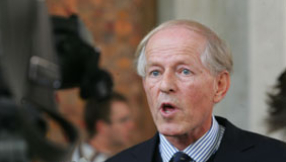'It's going to happen again,' warned Texas' Attorney General Ken Paxton after at least 26 people were killed and many more injured in the state's worst mass shooting on Sunday.
The target — a church — left the tiny community of Sutherland Springs devastated as residents turned out for a prayer vigil on Sunday night.
But statistically Paxton is right. It will happen again. And it will happen to other churches.
Since 1980 there have more than 145 attacks on churches in the US, according to a database by the Center for Homicide Research in Minneapolis which kept a record of church shootings from 1980-2005.
Averaging almost four every year, the list only records attacks directly on churches and said 185 people died, including 36 children, just up until 2005.
Since then even worse horrors have been witnessed in churches. Most prominently in 2015 the white supremacist Dylann Roof murdered 9 African-Americans at one of America's oldest black churches — Emanuel African Methodist Episcopal Church — in downtown Charleston, South Carolina.
Before that in July 2008 Jim David Adkisson confessed to walking into a children's musical performance at Tennessee Valley Unitarian Universalist Church, pulling out a shotgun, and firing on the audience. Two people died and 7 were wounded.
The year before in December 2007 the 24-year-old Matthew J. Murray killed four people at two different locations — the first was a Youth With A Mission training centre in Arvada, Colorado, after being told he couldn't stay the night and then at New Life Church in Colorado Springs, where Youth With A Mission has an office.
Earlier that year in August Eiken Elam Saimon shouting 'liar, liar!' opened fire on First Congregational Church in Neosho, Missouri. Three people died during that Micronesian service and five were wounded.
These are just a few examples.
The Center for Homicide Research in Minneapolis' research documents the extensive recent history of attacks on churches. Hatred of a particular group was behind a large proportion of the attacks. In 23 of the 139 cases from 1980-2005, the violence was targeted at a domestic partner. In 10 of the cases the motivation was 'religious difference' and one was labelled a hate crime.
Dallas Drake, the principal researcher for the Center, told Pacific Standard the idea came out of a discussion about settings where homicides had not occurred.
'We were having discussions internally about, "Is there any place that hasn't had mass shootings or mass murders?" and somebody came up with the idea of perhaps churches,' said Drake. 'Of course, we proved that wrong.'
Paxton, Texas' Attorney General, said the solution was not for less guns but more guns.
Churches should consider 'arming some of the parishioners' or hiring security guards, he told Fox News hours after the attack.
If more churchgoers were armed 'there's always the opportunity that the gunman will be taken out before he has the opportunity to kill very many people', he said.
'We've had shootings in churches for, you know, for forever. It's going to happen again, and so we need people in churches, professional security or at least arming some of the parishioner or the congregation so they can respond if something like this – when something like this happens again.'
President Donald Trump also seemed to suggest the solution was more guns rather than less guns.
Speaking from Tokyo on Monday he blamed the incident on the attacker's 'mental health problems' and said it 'isn't a guns situation.' He said it was lucky there was an armed local on the scene who shot at the attacker, otherwise 'it would have been much worse.'
But the research reveals an alarming trend of increasing violence.
Unless something dramatically changes in America's attitude to gun laws, we will see more and more mass shootings and more churches targeted by violence.
Read the full report on the Texas church shooting here.
And read about Ken Paxton's response here.













